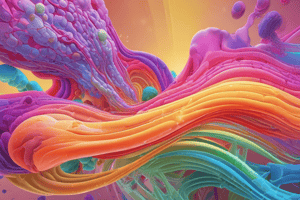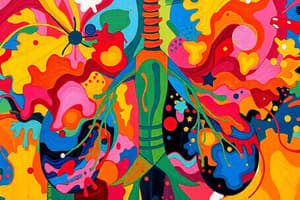Podcast
Questions and Answers
What is the role of glucose in the process of cellular respiration?
What is the role of glucose in the process of cellular respiration?
Glucose serves as a primary reactant that is broken down to release energy during cellular respiration.
How does temperature influence the rate of respiration in organisms?
How does temperature influence the rate of respiration in organisms?
Higher temperatures increase molecular movement, causing faster reactions and hence a higher rate of respiration.
Describe the gas exchange process during respiration in humans.
Describe the gas exchange process during respiration in humans.
Humans inhale oxygen which passes into the lungs and then into the blood through alveoli while carbon dioxide is expelled.
What is the significance of chlorophyll in photosynthesis?
What is the significance of chlorophyll in photosynthesis?
What products are generated during fermentation in yeast?
What products are generated during fermentation in yeast?
What is the primary purpose of respiration in living organisms?
What is the primary purpose of respiration in living organisms?
Write the word equation for aerobic respiration.
Write the word equation for aerobic respiration.
How do aquatic animals obtain the oxygen they need for respiration?
How do aquatic animals obtain the oxygen they need for respiration?
What role does chlorophyll play in the photosynthesis process?
What role does chlorophyll play in the photosynthesis process?
What is fermentation in yeast, and how does it differ from aerobic respiration?
What is fermentation in yeast, and how does it differ from aerobic respiration?
Flashcards
Respiration Objective 1
Respiration Objective 1
Respiration is a life process in all living organisms, releasing energy from glucose for processes like movement, growth, and reproduction.
Respiration Rate
Respiration Rate
The speed at which respiration occurs.
Respiration
Respiration
A life process releasing energy from food (like glucose) in all living things.
Aerobic Respiration Equation
Aerobic Respiration Equation
Signup and view all the flashcards
Glucose Concentration
Glucose Concentration
Signup and view all the flashcards
Respiration Raw Materials
Respiration Raw Materials
Signup and view all the flashcards
Oxygen Absorption - Humans
Oxygen Absorption - Humans
Signup and view all the flashcards
Oxygen Concentration
Oxygen Concentration
Signup and view all the flashcards
Oxygen Absorption - Animals (Aquatic)
Oxygen Absorption - Animals (Aquatic)
Signup and view all the flashcards
Temperature
Temperature
Signup and view all the flashcards
Aerobic Respiration
Aerobic Respiration
Signup and view all the flashcards
Glucose Source - Animals
Glucose Source - Animals
Signup and view all the flashcards
Word equation for aerobic respiration
Word equation for aerobic respiration
Signup and view all the flashcards
Respiration Air Composition Change
Respiration Air Composition Change
Signup and view all the flashcards
Respiration Rate
Respiration Rate
Signup and view all the flashcards
Digestion of Starch
Digestion of Starch
Signup and view all the flashcards
Yeast Respiration
Yeast Respiration
Signup and view all the flashcards
Independent Variable in Experiment
Independent Variable in Experiment
Signup and view all the flashcards
Dependent Variable in Experiment
Dependent Variable in Experiment
Signup and view all the flashcards
Study Notes
Respiration
- Respiration is a continuous life process occurring in all living organisms' cells.
- It's a chemical reaction that releases energy from glucose.
- This energy powers life processes like movement, growth, and reproduction.
- Respiration converts stored chemical energy in glucose into other usable energy forms, and releases some heat.
Aerobic Respiration
- Aerobic respiration uses oxygen.
- Word equation: Glucose + oxygen → carbon dioxide + water + energy
Obtaining Respiration Materials
- Humans get oxygen by breathing.
- Inhaled oxygen travels to the alveoli (air sacs) in the lungs.
- Oxygen diffuses from the alveoli into the blood.
- The heart pumps the oxygen-rich blood throughout the body.
- Aquatic animals obtain oxygen from water (e.g., fish use gills).
- Plants absorb oxygen through stomata (tiny holes) in their leaves.
- Single-celled organisms (like bacteria and yeast) absorb oxygen through their cell membranes.
- Animals obtain glucose from food.
- Sugary foods provide immediate glucose for respiration.
- Starchy foods require digestion to break down starch into glucose.
- Glucose is absorbed into the blood and transported to cells that require it for respiration.
Respiration Rate
- Factors affecting the rate of respiration include glucose concentration, oxygen concentration, and temperature.
- Higher concentrations of reactants (glucose and oxygen) lead to faster reactions.
- Higher temperatures provide more energy for molecules to move and react, thus increasing the reaction rate.
Respiration and the Air
- Respiration uses oxygen and produces carbon dioxide.
- The composition of inhaled air differs from exhaled air. Inhaled air has a higher percentage of oxygen and a lower percentage of carbon dioxide compared to exhaled air.
Photosynthesis
- Plants have special cells (like palisade mesophyll cells in leaves) containing chloroplasts to carry out photosynthesis.
- Chloroplasts contain chlorophyll that traps light energy.
- Other cells (like root hair cells) absorb water from the soil.
- Stomata on leaves allow for gas exchange—carbon dioxide uptake and oxygen release.
- Photosynthesis converts light energy into chemical energy.
- Word equation: Carbon dioxide + water → glucose + oxygen
Obtaining Photosynthesis Materials
- Plants obtain water through their roots.
- Plants absorb carbon dioxide from the air through stomata.
Additional Information
- Forests are often called the "lungs of the Earth" because they release oxygen during photosynthesis—essential for respiration by other organisms.
Studying That Suits You
Use AI to generate personalized quizzes and flashcards to suit your learning preferences.





